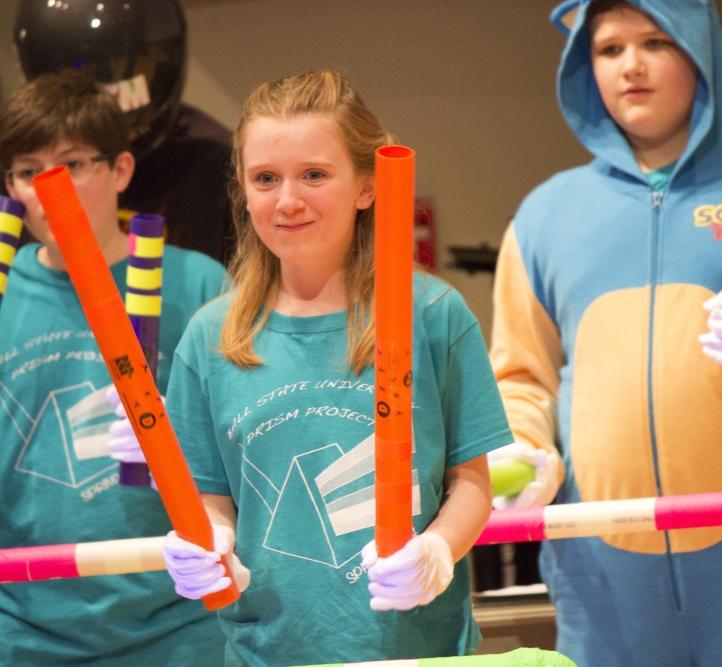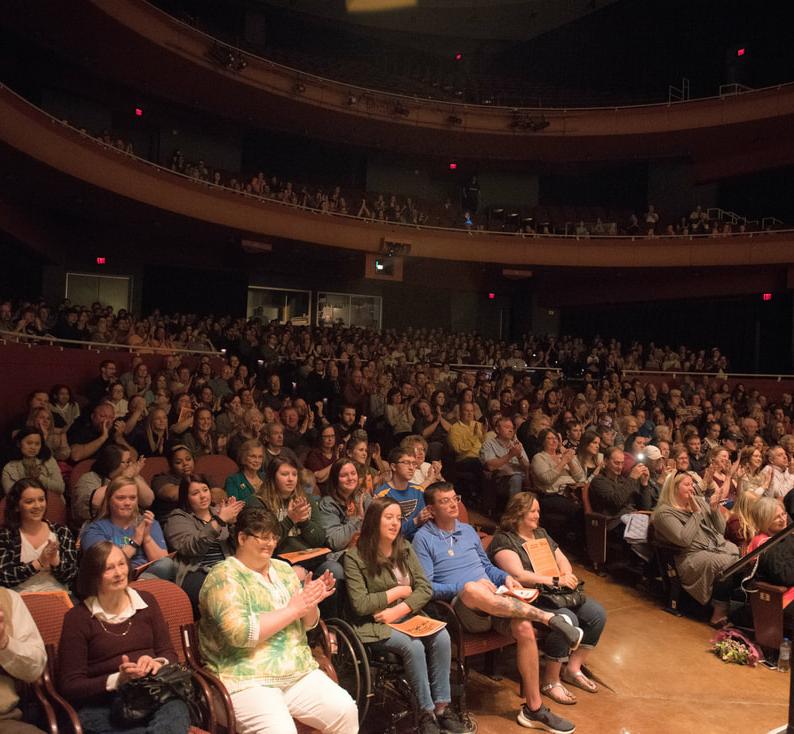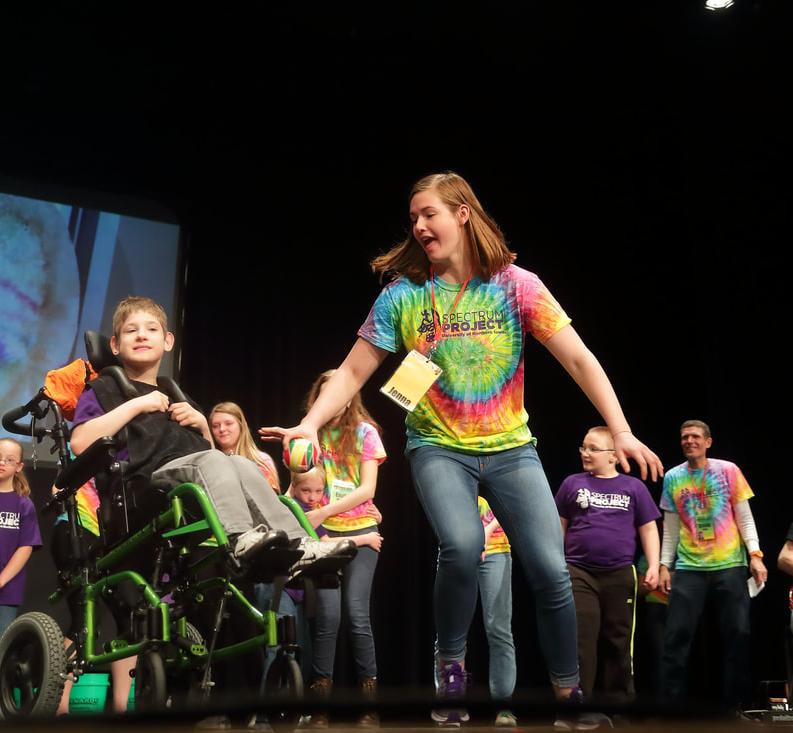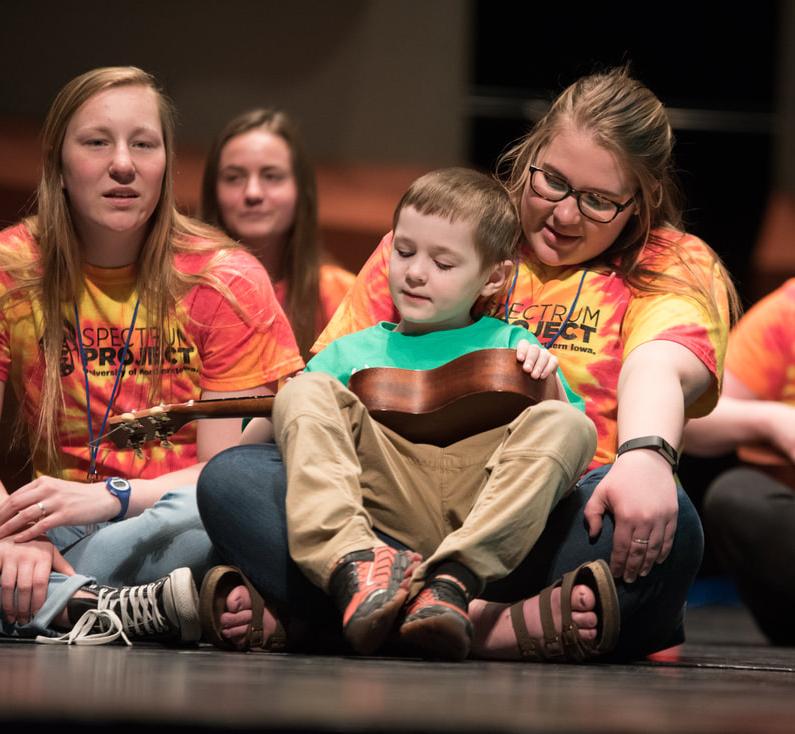About the Spectrum Project
The Spectrum Project is a music, movement, drama and art program for children with differing abilities. The Spectrum Project performers come from the Cedar Valley and range in age from 5 to 19. Spectrum Project Buddies and Staff include UNI, Allen College and Hawkeye Community College students who work each week with the performers.
Learn about the Spectrum Project
What is the Spectrum Project?
The Spectrum Project is a music, movement, drama and art program for children with differing abilities. The Spectrum Project performers come from the Cedar Valley and range in age from 5 to 19. Performers meet each Saturday beginning in January. We also have a Production & Design department for young adults, ages 18-24.
Spectrum Project Buddies include UNI, Allen College and Hawkeye Community College students who volunteer each week to work with performers. Each performer is paired with a Spectrum Project Buddy for the duration of the project.

How did the Spectrum Project begin?
The Spectrum Project is a continuation of efforts to provide performing arts experience for children with differing abilities in the Cedar Valley. This effort began with the Spectrum Theatre, founded by UNI Theatre Professor Gretta Berghammer in 2012.
The Spectrum Project is modeled after the Ball State Prism Project, founded by Ryan and Amy Hourigan in 2010 at Ball State University in Muncie, Indiana. The BSU Prism Project is a performing arts program for students with special needs and a training ground for Ball State students who wish to work with children who have exceptionalities.
The Spectrum Project is supported through participating families, the UNI School of Music and community supporters.

Three Goals of the Spectrum Project
1. PERFORMERS
The first goal of the Spectrum Project is to provide an arts experience for all children, regardless of what challenges the child might be facing. We believe the arts are for everyone and we practice that through designing arts experiences that take the ideas of children and put them into something the children find enjoyable and rewarding.
2. COLLEGE STUDENTS
The second goal of the Spectrum Project is to provide an opportunity for college students to interact and learn from children and people with differing abilities. Many of UNI's student population are connected to education or communication sciences. The Spectrum Project allows college students to experience the rewards of working with children of all abilities. Since it began in 2015, the Spectrum Project has impacted the lives of over 400 college students.
3. COMMUNITY AND SOCIETY
The third goal of the Spectrum Project is the largest and possibly the most important goal: to change the community's and society's perception of people with differing abilities or who are different from us. All the Spectrum Project performances are free to the public to attend. Approximately 250 people attended the first show in 2015. In 2018, the show had to move to the Gallagher-Bluedorn Performing Arts Center and the audience was estimated at over 1000. The world is a better place when we can accept the differences of others. The diversity among our performers and all of us is what makes the world a beautiful place to live.

What is the Spectrum Project?
The Spectrum Project is a music, movement, drama and art program for children with differing abilities. The Spectrum Project performers come from the Cedar Valley and range in age from 5 to 19. Performers meet each Saturday beginning in January. We also have a Production & Design department for young adults, ages 18-24.
Spectrum Project Buddies include UNI, Allen College and Hawkeye Community College students who volunteer each week to work with performers. Each performer is paired with a Spectrum Project Buddy for the duration of the project.

How did the Spectrum Project begin?
The Spectrum Project is a continuation of efforts to provide performing arts experience for children with differing abilities in the Cedar Valley. This effort began with the Spectrum Theatre, founded by UNI Theatre Professor Gretta Berghammer in 2012.
The Spectrum Project is modeled after the Ball State Prism Project, founded by Ryan and Amy Hourigan in 2010 at Ball State University in Muncie, Indiana. The BSU Prism Project is a performing arts program for students with special needs and a training ground for Ball State students who wish to work with children who have exceptionalities.
The Spectrum Project is supported through participating families, the UNI School of Music and community supporters.

Three Goals of the Spectrum Project
1. PERFORMERS
The first goal of the Spectrum Project is to provide an arts experience for all children, regardless of what challenges the child might be facing. We believe the arts are for everyone and we practice that through designing arts experiences that take the ideas of children and put them into something the children find enjoyable and rewarding.
2. COLLEGE STUDENTS
The second goal of the Spectrum Project is to provide an opportunity for college students to interact and learn from children and people with differing abilities. Many of UNI's student population are connected to education or communication sciences. The Spectrum Project allows college students to experience the rewards of working with children of all abilities. Since it began in 2015, the Spectrum Project has impacted the lives of over 400 college students.
3. COMMUNITY AND SOCIETY
The third goal of the Spectrum Project is the largest and possibly the most important goal: to change the community's and society's perception of people with differing abilities or who are different from us. All the Spectrum Project performances are free to the public to attend. Approximately 250 people attended the first show in 2015. In 2018, the show had to move to the Gallagher-Bluedorn Performing Arts Center and the audience was estimated at over 1000. The world is a better place when we can accept the differences of others. The diversity among our performers and all of us is what makes the world a beautiful place to live.

Buddies
What is a buddy?
Buddies are volunteers who come during rehearsal to help a performer. Staff members design the show and the activities, teach the routines to the performers and keep the whole project enjoyable and safe.

When does the Spectrum Project happen?
Every Saturday of the spring semester beginning the first Saturday after the first week of classes and going until early April, depending on the year. There are no rehearsals the Saturdays before and after Spring Break. Buddy training is the Sunday before UNI classes begin. 1-5pm at Lincoln Elementary. Rehearsals are 1:00-2:30pm with a 12:15pm report time.

What does a Buddy do?
Buddies are paired with performers, but we work in groups and there are directors who work with the groups. We also have support staff to help. We also have buddy positions for those who just want to help but would rather not be paired with a performer. We provide training the Sunday before classes begin. We also have an AMAZING support staff who is there to help at any time. No previous experience in any area is needed to be a buddy, but all buddies are expected to explore the "silly side" of themselves.

What is a buddy?
Buddies are volunteers who come during rehearsal to help a performer. Staff members design the show and the activities, teach the routines to the performers and keep the whole project enjoyable and safe.

When does the Spectrum Project happen?
Every Saturday of the spring semester beginning the first Saturday after the first week of classes and going until early April, depending on the year. There are no rehearsals the Saturdays before and after Spring Break. Buddy training is the Sunday before UNI classes begin. 1-5pm at Lincoln Elementary. Rehearsals are 1:00-2:30pm with a 12:15pm report time.

What does a Buddy do?
Buddies are paired with performers, but we work in groups and there are directors who work with the groups. We also have support staff to help. We also have buddy positions for those who just want to help but would rather not be paired with a performer. We provide training the Sunday before classes begin. We also have an AMAZING support staff who is there to help at any time. No previous experience in any area is needed to be a buddy, but all buddies are expected to explore the "silly side" of themselves.

